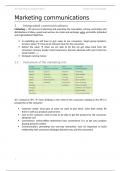SV Marketing Communications Chyna Van Herreweghe
Marketing communications
1 Integrated communications
Marketing = the process of planning and executing the conception, pricing, promotion and
distributions of ideas, goods and services to create and exchange value and satisfy individual
and organizational objectives
In marketing we will have to give value to our consumers, target group (product,
services, ideas) it has to be relevant value for the consumers
Deliver the value when we are able to do this we get value back from the
consumers (money, loyalty, brand awareness, become advocate with your brand (on
social media), …)
End-goal: earning money
1.1 Instrument of the marketing mix
4C’s instead of 4P’s more thinking in the mind of the consumer, looking to the 4P’s in
perspective of the consumer
Customer needs: what type of value we want to give them, solve their needs, fill
them in with our products and services
Cost to the customer: what it costs to be able to get the product for the consumer,
adequate cost
Convenience: online/offline determines how convenience it is to get your product
(buying groceries online)
Communication: promoting was one-way interaction, now it’s important to build
relationship with consumers (dialogue between you and the consumers)
1
,SV Marketing Communications Chyna Van Herreweghe
1.2 Marketing communications (MC)
Marketing communications = the process through which organizations and audiences
engage with one another
Messages about the values we give to our consumers consumers + stakeholders (retailers,
suppliers, government, …) we want to build long-lasting relationships with them and our
communication supports this
Cognitive = what they think about the product or message
Attitudinal = positive/negative attitude towards the product or message
Behavioral = will they buy it or not? do they talk about it on social media?
Noise surrounding our message what makes it hard to bring the message around make it
as clear as possible
1.3 Instrument of the communications mix
Online and offline tools should be integrated with each other (don’t see them as separate
things)
1.3.1 Advertising
Characteristics:
Non-personal
One-to-many
Monologue
Paid
Often long term
Via intermediary effects: in-between effects you have to reach which results in the
long-term that they will buy your product
Persuasion knowledge: people are very aware that they are being persuaded and that
the company is trying to sell
Create some effects that are not in the ST not immediate selling, but good
understanding of what your brands stands for, prefer your brand over competitors,
creating an image in the mind of consumers, …
Example: classic advertising like billboards, television advertising, newspaper, radio, … are
non-personal (not personalized for you) = mass communication tools
2
,SV Marketing Communications Chyna Van Herreweghe
1.3.2 Online advertising
Characteristics:
Specific target group: ability to be way more specific (on social media, online, …)
because we have more information
Personalized
Short term: reach more effects in the ST: immediately click on a link and go to the
webshop generate more sales from online advertising
Measurability: how many people click on your link, how many people bought your
product, …
Examples:
- Search enginge
- Websites
- E-mail
- Social media advertising
- Mobile advertising
1.3.3 Brand activation
= the integration of all available communications means in a creative platform in order to
activate consumers by stimulating interest, initiating trial and eventually securing consumer
loyalty
Characteristics:
Trying to get sales in the ST
Focus is a lot about making people do thing (buying it, interacting with the product,
…) focus on behavior
(1) Sales promotion:
Sales stimulation (ex: If you buy one product, you get one free)
Incentive-based: everything where you get rewarded for buying a product
Image destroying?
- Type of promotion
- Type of reward
Damages your image as a brand if you give a lot of discounts on your products
people will stop buying your products when they are on their normal price and wait
until there is a next sales promotion
IMP: making price perception lower give something extra that offers extra value (saving
card, another product, …)
3
, SV Marketing Communications Chyna Van Herreweghe
(2) In-store communications
Goal: make people buy your product immediately
Decisions are mostly made in store attract a lot of consumers
Free samples (trying products, so not always discount), shelf stoppers, …
(3) Point-of-purchase communications
Same principle: at the place where they can buy it activates them immediately
The place where a lot of decisions are being made
(4) Experience marketing
Creating an experience where the result is an emotional connection to a person,
brand, product or idea
Creating connection through a designed emotive experience
Field marketing, customer service, special events, product promotions, PR stunts, …
Examples:
- Flagship stores of Nike, M&M’s try the product and see all the products they
have in a very nice environment
- Test drive
1.3.4 Direct marketing
Characteristic:
Personal: people will react to it more quickly because it feels more personal
Measurable
Increasingly online
Difference here: directly talking to the consumer like newsletter (direct to your mailbox, so it
feels direct) – called by a company
Examples:
- Direct mailing
- Telemarketing
- Catalogue selling
1.3.5 Public relations
Characteristics:
Mainly corporate communications tool: mainly you want to create goodwill we
want the society to have a positive image about your brand in mind (stories picked up
by media, publicity, …)
Building and maintaining goodwill and reputation
Generate positive publicity
Many stakeholders
Free: you earn the publicity (you can’t choose what media will write about your
company/brand)
Reach consumers, government, retailers, pressure groups, suppliers, … = everybody
who is interested
Public relati ons (PR) VERSUS adverti sing
4




